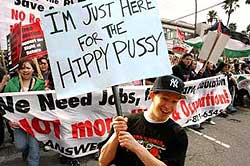Are biofuel subsidies REALLY "going green"? Nope.
Researchers at the Smithsonian Tropical Research Institute (STRI), known for their global warming alarmism at that, argue that American biofuel subsidies are boosting deforestation in the Amazon. How? STRI's staff scientist William Laurance explains the cascade of effects that occur as the result of $11 billion per year in corn subsidies.
The US is the world's leading producer of soy, but many American soy farmers are shifting to corn to qualify for the government subsidies. Since 2006, US corn production rose 19% while soy farming fell by 15%.
The drop-off in US soy has helped to drive a major increase in global soy prices, which have nearly doubled in the last 14 months. In Brazil, the world's second-largest soy producer, high soy prices are having a serious impact on the Amazon rainforest and tropical savannas.
"Amazon fires and forest destruction have spiked over the last several months, especially in the main soy-producing states in Brazil," said Laurance. "Just about everyone there attributes this to rising soy and beef prices."
High soy prices affect the Amazon in several ways. Some forests are cleared for soy farms. Farmers also buy and convert many cattle ranches into soy farms, effectively pushing the ranchers further into the Amazonian frontier. Finally, wealthy soy farmers are lobbying for major new Amazon highways to transport their soybeans to market, and this is increasing access to forests for loggers and land speculators.
Remember the First Law of Ecology is "everything is connected to everything else." That also applies to market economics.
Researchers at the Smithsonian Tropical Research Institute (STRI), known for their global warming alarmism at that, argue that American biofuel subsidies are boosting deforestation in the Amazon. How? STRI's staff scientist William Laurance explains the cascade of effects that occur as the result of $11 billion per year in corn subsidies.
The US is the world's leading producer of soy, but many American soy farmers are shifting to corn to qualify for the government subsidies. Since 2006, US corn production rose 19% while soy farming fell by 15%.
The drop-off in US soy has helped to drive a major increase in global soy prices, which have nearly doubled in the last 14 months. In Brazil, the world's second-largest soy producer, high soy prices are having a serious impact on the Amazon rainforest and tropical savannas.
"Amazon fires and forest destruction have spiked over the last several months, especially in the main soy-producing states in Brazil," said Laurance. "Just about everyone there attributes this to rising soy and beef prices."
High soy prices affect the Amazon in several ways. Some forests are cleared for soy farms. Farmers also buy and convert many cattle ranches into soy farms, effectively pushing the ranchers further into the Amazonian frontier. Finally, wealthy soy farmers are lobbying for major new Amazon highways to transport their soybeans to market, and this is increasing access to forests for loggers and land speculators.
Remember the First Law of Ecology is "everything is connected to everything else." That also applies to market economics.










